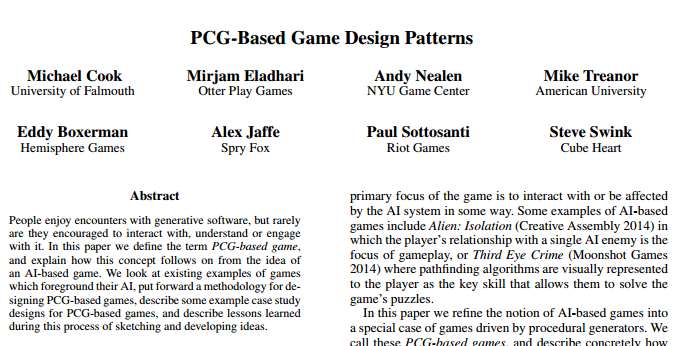
PCG-Based Game Design Patterns
Games that use procedural content generation usually hide the generation from the players. Once the world is created you can’t interact with the generator.
In this research paper, a list of luminaries—Michael Cook, Mirjam Eladhari, Andy Nealen, Mike Treanor, Eddy Boxerman, Alex Jaffe, Paul Sottosanti, and Steve Swink—talk about designing games that are based on the users interacting with the generators.
(Speaking of Mike Cook, this is a good time to remind everyone that the talks for ProcJam are tomorrow.)
Some games let you interact with the generator at the start of the game—Civilization’s map settings, Minecraft’s seeds, or even the desks in Magic: The Gathering or set of available cards in Dominions. Some even let you add new patterns, such as the editor for Race the Sun. But it’s rarer for games to let you interact with the generator while you play the game: games like Warning Forever and Galactic Arms Race are not the norm.
The taxonomies for interaction and content laid out in the paper are a good starting point for thinking about some of the things you can do with a generator. Some of these are areas I think there’s a lot of potential to innovate. I’m looking forward to seeing what narrative generators come out of this years NaNoGenMo, for example.
I also think that generative progression systems are underexplored, despite roguelikes and action roguelikes (such as Diablo) using them. There’s a lot of possibilities to explore here, beyond loot and weapon generation.
Imagine a progression system generator that creates different kinds of gameplay based on your choices. Instead of hand-authoring branching content, the generator can create it on the fly. This shades into the level creation in Lenna’s Inception or Becky Lavender’s Zelda Dungeon Generator, which combine environment generation with an elaborate system to create the proper constraints for the player’s choices.
The design patterns themselves—the AI as creative proxy, meta-environment, the player as a filter or fitness function; and games where the player can interact with the generative system itself—are all rich potential veins of ideas.

The paper wraps up with two game designs that use these ideas. Sliding Doors is a Telltale-style adventure game design that uses the user’s choices to prune the future story tree. Tombs of Tomeria is a dungeon exploration game where the player can influence and reshape the cellular automata that generate the map.
There’s lots of ideas to dig into here. I’m likely going to reference this a lot as I think about my upcoming projects. If you’d like to read the paper for yourself, you can find it here: https://arxiv.org/pdf/1610.03138v1.pdf
